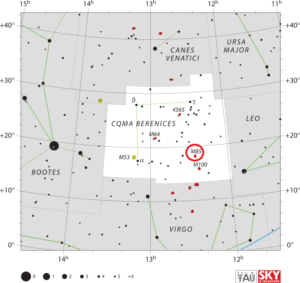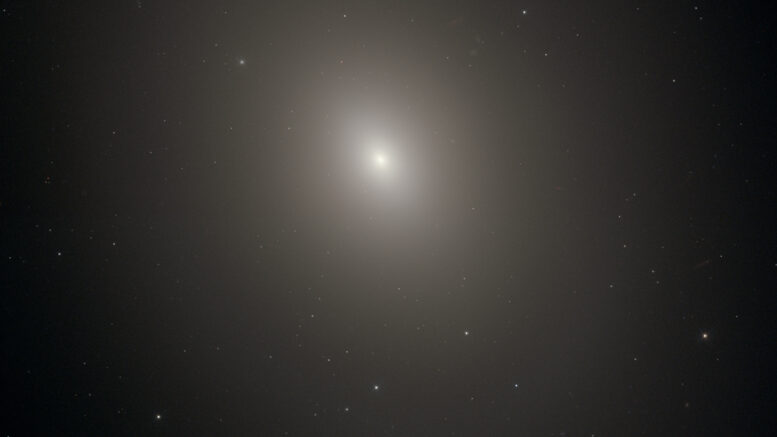Messier 85 is a lenticular or elliptical galaxy located in the Virgo Cluster of galaxies, in the constellation Coma Berenices. Messier 85 is interacting with two neighboring galaxies: the spiral galaxy NGC 4394 and the elliptical galaxy MCG 3-32-38. Messier 85 has very little neutral hydrogen and its outer structure indicates that it underwent a merger with another galaxy about 4 to 7 billion years ago.
| Description | |
| Visible From Pacific Northwest | January to May |
| Best Time To Observe | May |
| Minimum Size Of Viewing Device | 10×50 binoculars |
| Object Type | Lenticular or Elliptical Galaxy |
| Designations | Messier 85, M85, NGC 4382, ISD 0135852, PGC 40515, UGC 7508, 2E 2700, 2E 1222.8+1828, MCG+03-32-029, 2MASX J12252405+1811278, VCC 798, Z 99-45, Z 1222.9+1828, GIN 779, KPG 334a |
| Right Ascension | 12h 25m 24.0s |
| Declination | +18°11’28” |
| Constellation | Coma Berenices |
| Number Of Stars | 400 Billion |
| Apparent magnitude | +10.0 |
| Apparent dimensions | 7′.1 x 5′.5 |
| Object Radius | 62,500 light years |
| Distance From Earth | 60 million light years |
History
The M85 galaxy was discovered by the French astronomer Pierre Méchain on March 4, 1781. He reported the discovery to his friend Charles Messier, who determined the position for the object and included it in his catalogue of deep sky objects on March 18, 1781. On the same night, Messier discovered seven other members of the Virgo Cluster – Messier 84, Messier 86, Messier 87 (Virgo A), Messier 88, Messier 89, Messier 90 and Messier 91 – as well as the globular cluster Messier 92, located in Hercules.
Messier described M85 as a “nebula without star, above & near to the ear of the Virgin, between the two stars in Coma Berenices, No.s 11 & 14 of the Catalog of Flamsteed,“ adding that “this nebula is very faint.”
William Herschel observed this area of the sky on March 14, 1784 and noted, “Two resolvable nebulae; the preceding [western] is the largest, and with 157 seems to have another small nebula joined to it, but with 240 it appears to be a star. The following neb. is II.55 [NGC 4394].”
John Herschel catalogued M85 as h 1242 in 1833 and later included the object in the General Catalogue as GC 2946. He described it as “very bright; pretty large; round; brighter toward the middle; star north preceding [to the NW].”
Locating M85 In The Sky
The galaxy lies at the northern edge of the Virgo Cluster, whose centre can be found roughly halfway between the bright stars Denebola in Leo and Vindemiatrix in Virgo constellation. M85 is located about 6 degrees to the northwest of the cluster’s centre. It can be found 1 degree northeast of the magnitude 4.7 star 11 Comae Berenices.

Viewing M85
The best time of year to observe M85 is during the spring. The galaxy is relatively faint and not easy to spot in 10×50 binoculars. Small telescopes will show only a fuzzy ball of light with a bright centre. 6-inch and 8-inch telescopes reveal a bright, round patch of light with a significantly brighter core. However, even larger instruments do not reveal much more detail.
Photographing M85
Photographers of Messier 85 can find inspiration on sites such as cloudy nights and astrobin, as there are not a plethora of options elsewhere. There will need to be filters added to photograph M85, as it would seem that 6 to 8 inch telescopes might be enough to capture a good image. Larger telescopes would obviously be able to gather more light, but would be allow for better images.
https://www.astrobin.com/search/?q=M85
http://www.astrophoton.com/M085.htm
https://www.cloudynights.com/topic/692126-messier-85-quick-process/
Sources And Further Reading
Descriptions of all of Messier Objects can be found here.
https://www.nasa.gov/feature/goddard/2018/messier-85
http://www.messier.seds.org/m/m085.html

Be the first to comment on "Messier 85"